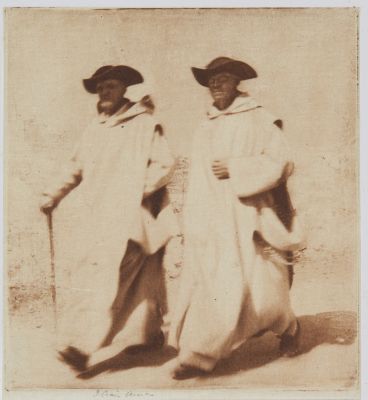
Title
A Venetian RequiemArtist
Annan, James Craig (Scottish, 1864-1946)Key FigurePublication
Venice and LombardyDate
1896Process
Photogravure (tissue)Atelier
James Craig AnnanImage Size
12 x 8.8 cm
In 1899 F. Matthies-Masuren wrote about this image, A Venetian Requiem has a lively and picturesque effect. James Craig Annan’s perception of space is of great importance. It is of a street scene showing the passing of a procession. There are – that is – there were two figures in the foreground quite near to the camera. Naturally they turned out to be far too large, dull and under exposed. The procession moves between these two figures in a lively exchange of darker and light patches. This draws the viewer’s full attention and he is not concerned about an explanation for the two dark areas in the foreground which are seemingly necessary for the overall effect of the image. This is an original idea to say the least. A similarly fortunate solution would rarely be successful. One would not normally get beyond the ‘view.’ [1] Annan carefully placed the text, ‘Requiem Aeternam Dona Ei Domine Et Lux. . .’ with the figures in the procession innovatively incorporating text and image now both reproduced photographically. Integrating text into his photographs was a technique inspired by the German Rennaisance painter, Hans Holbein the Younger.
Since the early nineties James Craig Annan had been one of the chief forces in the development of pictorial photography. This portfolio of prints is his masterpiece. Limited to an edition of 75, the eleven plates include some of Annan’s most sophisticated and celebrated early work. The small photogravures masterfully etched and printed by Annan himself on Japan tissue and individually signed, explore for the first time the instantaneous moments accessible only to the camera combined with the control, art and craft of traditional etching. The tension between photography emulating painting and a truthful photography able to represent a new art form is clearly visible in Venice and Lombardy and reveals Annan’s ability to articulate the most advanced issues of his time. The portfolio, according to Ken Jacobson, contains signed, tiny, gem-like photogravures that might be seen as the precursor for the style of Camera Work – Stieglitz’s widely praised journal, vehicle of modern photography and photogravure tour-de-force. Stieglitz greatly admired Annan and was certainly influenced by this work. [2]
References
[1] F. Matthies-Masuren] ‘J. Craig Annan Glasgow’. Photographisches Centralblatt, 5th Year, no. 4 (5 Feb. 1899), p. 81-85.
[2] Aesthetic Lives : ‘New Experiences, New Subjects of Poetry, New Forms of Art’. The Rivendale Press, 2013. Bologna, Gabriella, The Aesthetics of British Photography. A Case Study: James Craig Annan’s Portfolio Venice and Lombardy High Wycombe Bucks England: Rivendale Press. P. 92











